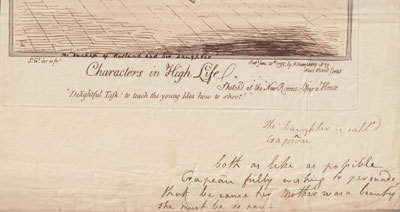Characters in High Life
This is a portrait and satiric caricature of two young women who are following the fashion of the mid 1790s and wearing headdresses consisting of huge plumes emerging from a turban-like cap. (See A Lady Putting on her Cap, (June 30, 1795) for a more specific jab at the absurd lengths to which this fashion might lead.) The taller and less caricatured woman seems to be leading an unhappy and grossly caricatured child with oversized plumes and fan among the crowd assembled in the "New Rooms, Opera House."

© Trustees of the British Museum
The caption from The Seasons by the well-known poet, James Thomson,—Delightful Task! to teach the young Idea how to shoot!— suggests a kind of parent-child relationsip between the two figures. Here is the larger context from which the quotation is derived. It makes clear that the passage is based on a plant metaphor, the "infant reason" being taught to send out appropriate growths (shoots) by "the kind hand of an assiduous care."
Then infant reason grows apace, and calls
For the kind hand of an assiduous care.
Delightful task! to rear the tender thought,
To teach the young idea how to shoot,
To pour the fresh instruction o'er the mind,
To breathe the enlivening spirit, and to fix
The generous purpose in the glowing breast.
Of course in this instance the allusion is ironic. There is no "generous purpose" being instilled here; nothing but shallow fashion and vanity.
The title, Characters in High Life suggests that in addition to its satiric glance at an absurd fashion, this print functions as a portrait caricature of a pair of identifiable young women. The consensus of all the commentataries I've seen is that the tall woman is intended to represent Mary Isabella Manners (née Somerset), Duchess of Rutland (1756-1831) who was a political hostess and opera buff. The short woman has been identified by Wright and Evans as her unmarried sister [sic], Lady Gertrude Manners. But this is clearly a mistake. The Duchess had no unmarried sisters; and her two married sisters were both older than she. A better guess (and more in keeping with the caption) would be the youngest of her two daughters: Catherine Mary (Manners) Weld Forester (1779 - 1829).
But there is some reason to question both suppositions. In 1795, the Duchess of Rutland was 39 years old and her youngest daughter 16. In other words, both would have been older than the two figures appearing in Gillray's print. As one can see by looking at the available images of the Duchess in the National Portrait Gallery, portraits of the Duchess of Rutland vary greatly. And most of them do NOT look like Gillray's central figure. But there is a stipple engraving by William Lane after Richard Cosway published in 1791 which Gillray could have seen and based his portrait on and which DOES bear some resemblance to Gillray's figure. Especially if you flip the image (as I have done below) so that she faces the same way as Gillray's, one could believe that the woman in Gillray's print is indeed intended for the Duchess of Rutland.

1797 & 1791]
© Wikimedia
But that still leaves the other figure whose height is childlike but whose face is almost mannish. The images in the National Portrait Gallery of Catherine Mary (Manners) Weld Forester, the Duchess's daughter do NOT look like Gillray's figure, so the identity of the second figure of the print is still a mystery.
Addendum
Since publishing the commentary above, I have heard from Donald Coverdale that his copy of Characters in High Life contains annotations that tend to corroborate the identification of the two figures as the Duchess of Rutland and one of her two daughters .

© Donald Coverdale, Private Collection
Especially the second of the two annotations which mentions that Gillray's portraits are "both as like as possible" clearly suggests a contemporary observer who could make the comparison. And the further details about the nickname for the Duchess' daughter (Crapeau i.e. French for toad) are consistent with someone small and homely.
Sources and Reading
- Commentary from the British Museum on Characters in High Life.
- "Mary Isabella (Somerset) Manners (1756 - 1831) ," Wikitree
- "Catherine Mary (Manners) Weld Forester (1779 - 1829)," Wikitree
- "Royal Opera House," Wikipedia
- James Thomson, "Spring" from The Seasons
- Thomas Wright and R.H. Evans, Historical and Descriptive Account of the Caricatures of James Gillray #404.
- Thomas Wright and Joseph Grego, The Works of James Gillray, the Caricaturist; With the History of His Life and Times, p. 196.
Comments & Corrections
NOTE: Comments and/or corrections are always appreciated. To make that easier, I have included a form below that you can use. I promise never to share any of the info provided without your express permission.